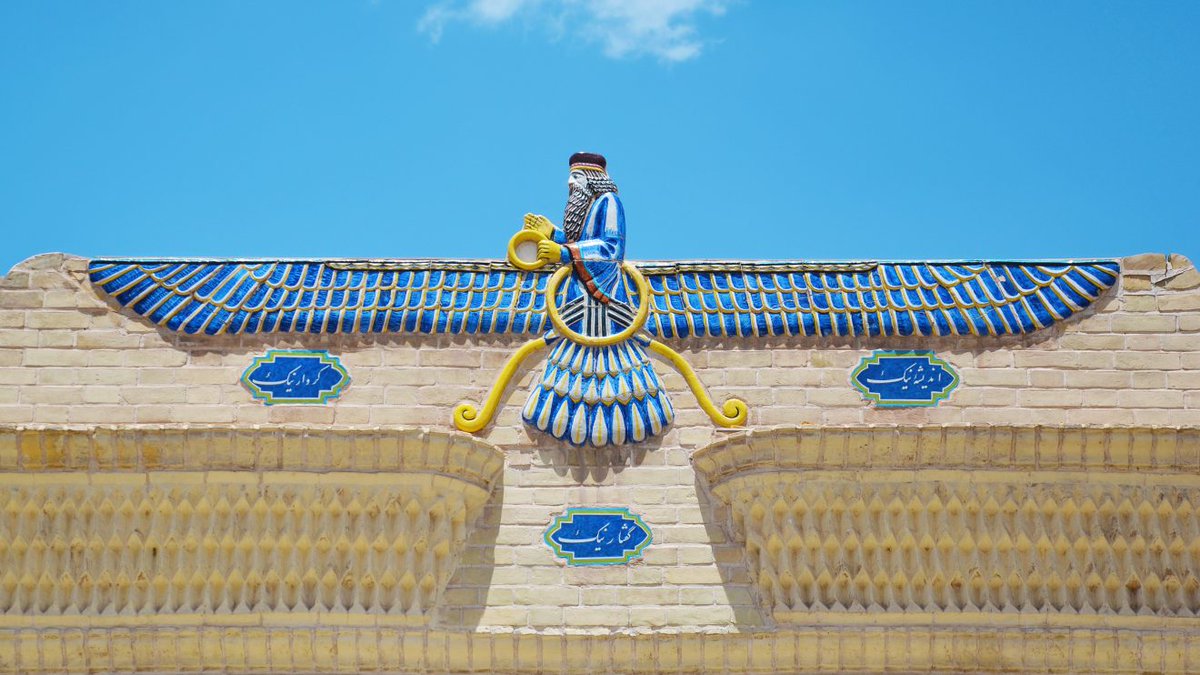Ancient Iranian Devices, Insignia & Monograms
نشان های کهن ایرانی
One of the most enigmatic, least studied aspects of #Iranian history & culture
Check this thread out to find out more, and please #retweet & share. You won't find all this info elsewhere!
🧵⤵️⚡️
نشان های کهن ایرانی
One of the most enigmatic, least studied aspects of #Iranian history & culture
Check this thread out to find out more, and please #retweet & share. You won't find all this info elsewhere!
🧵⤵️⚡️

I might one day turn this into a paper. But for now, let's look at this really cool part of our history! I am so excited!!
What I will call "devices" are abstract signs, seals... that got progressively more complex by end of #Sasanian era. They are also called #Tamga (or tamgha)
What I will call "devices" are abstract signs, seals... that got progressively more complex by end of #Sasanian era. They are also called #Tamga (or tamgha)
Tamga from Turkish. In Middle Persian and modern Persian, the word would be Nishaan or Neshaan ( Ossetian gakk)
These have an amazing and long history. They might have started as signs for cattle, later for clans & families. Were used by people across Eurasia
These have an amazing and long history. They might have started as signs for cattle, later for clans & families. Were used by people across Eurasia
Many of the signs are similar or were used later too. But we have to pay particular attention to differences, as one line or simple change could mean it is a different clan or individual's device
We can start with some signs from satraps in #Achaemenid era



We can start with some signs from satraps in #Achaemenid era




As I mentioned, many other people across Eurasia also used these signs
These are some used by #Sarmatians


These are some used by #Sarmatians



These are some that were used by #Ossetians 

And these were used by Abazin (1) and Kabardin (2) people in the #Caucasus 



برای هزاران سال, نشانهای خاندانی و شخصی در آسیا و اروپا استفاده میشده.
این مبحث نیاز به پژوهش بسیار دارد, بخصوص در زمان #ساسانیان. اگر هم دوستی میتواند ویکیپیدیا رو به روز برسونه با اطلاعات این رشتو, عالی خواهد بود 🙏🙏
Also see old #Turkic tamgas
این مبحث نیاز به پژوهش بسیار دارد, بخصوص در زمان #ساسانیان. اگر هم دوستی میتواند ویکیپیدیا رو به روز برسونه با اطلاعات این رشتو, عالی خواهد بود 🙏🙏
Also see old #Turkic tamgas

Now moving to #Parthian / Arsacid period, again we have what appear to be personal devices, more so in Indo-European sphere, Elymais which was ancient Elamite, and some other regions.
These are generally Parthian symbols on coins, many from Greek inspiration or Greek letters
These are generally Parthian symbols on coins, many from Greek inspiration or Greek letters

etc., especially in earlier Parthian era
Here we can see the anchor emblem of #Elymais
حال به دوره اشکانی نگاهی میکنیم و نشانهای پیرامون اون شاهنشاهی.


Here we can see the anchor emblem of #Elymais
حال به دوره اشکانی نگاهی میکنیم و نشانهای پیرامون اون شاهنشاهی.



The general Indo-Parthian device. Note that this is different from a later Sasanian one, although similar to it. 



And the possible device of last king of the #Parthian dynasty, Artabanus IV 



Note a possible connection with Achaemenid satrapy devices, though it might just be a coincidence and similarity.
Apparently direction of appearance did not matter on this Achaemenid coins, it could be up, sideways etc.


Apparently direction of appearance did not matter on this Achaemenid coins, it could be up, sideways etc.



And local kings and rulers also had their own individual and clan signs. Here is just one possible one from Persis in western Iran
This is before Sasanian era. Ardashir II (Artaxerxes II)
⤵️
This is before Sasanian era. Ardashir II (Artaxerxes II)
⤵️

Now let's look at some Central Asian signs, tamgas, devices too before moving to Sasanian era
خوب حالا چند تا هم از آسیای مرکزی ببینیم و سپس برویم سراغ ساسانیان
Some possible #Kushan ones
خوب حالا چند تا هم از آسیای مرکزی ببینیم و سپس برویم سراغ ساسانیان
Some possible #Kushan ones
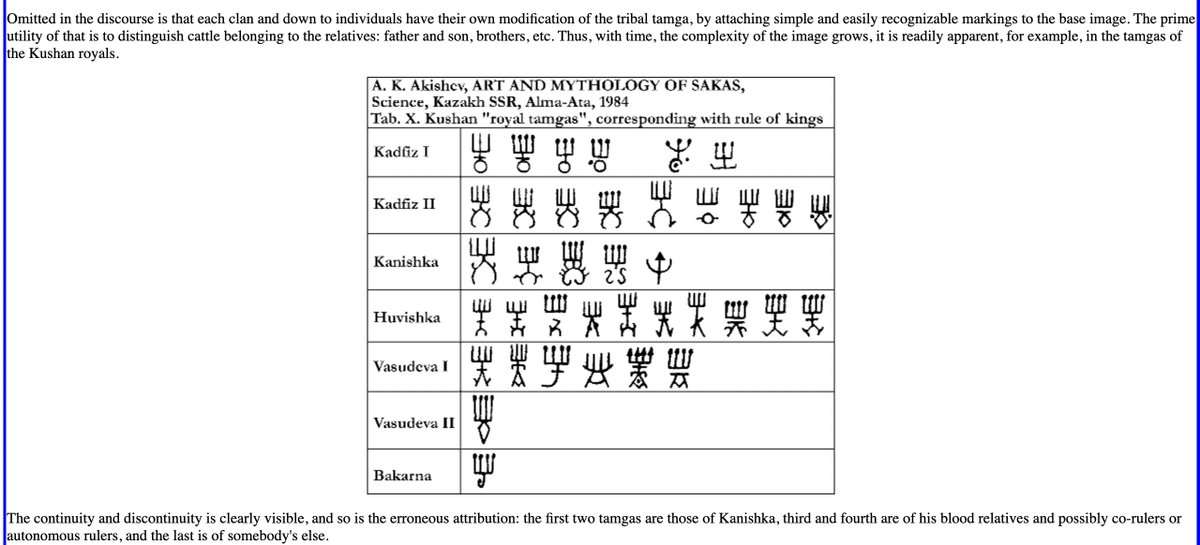
#Alchon Huns
Some images here from @sasanianshah 's great book ReOrienting the Sasanians
Also you should check out @rasoulipour's great project on Sasanian insignia: eranshahr.com/insignia
I will sign up soon to help that project too :)

Some images here from @sasanianshah 's great book ReOrienting the Sasanians
Also you should check out @rasoulipour's great project on Sasanian insignia: eranshahr.com/insignia
I will sign up soon to help that project too :)


Alchon/ Alkhans, including coins of #Khingila 





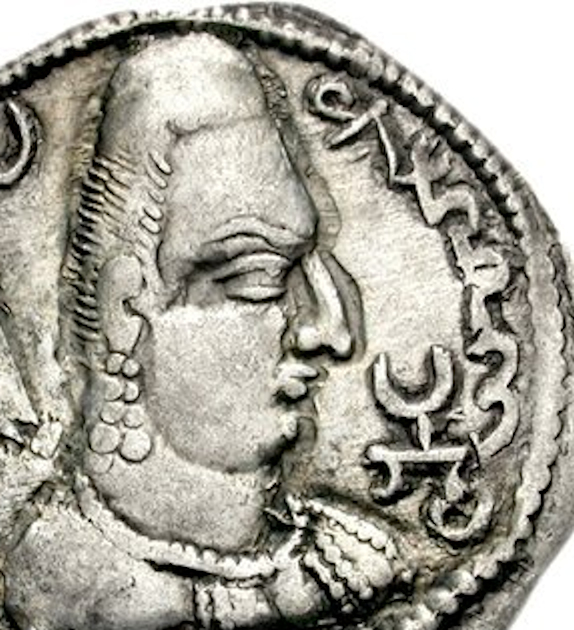

#Hephthalite Tamgha 



And coin of Sapadbizes, #Yuezhi 

And a cool pegasus on a plate, Possibly #Sogdian, 8C, from Christie's, some sort of Central Asian or Iranian Tamga/ device
⤵️
⤵️

Now to #Sasanians !
بریم سر اصل مطلب...
I've done a great deal of research on this and lost some sleep just because of how excited I've been 😅 Couldn't wait to share it!
1) #Ardashir I, and by extension Sasanian dynasty's clan sign

بریم سر اصل مطلب...
I've done a great deal of research on this and lost some sleep just because of how excited I've been 😅 Couldn't wait to share it!
1) #Ardashir I, and by extension Sasanian dynasty's clan sign


We first encounter this device on the "Battle of Hormozdgan" relief at Firuzabad, showing Ardashir I's victory over Artabanus IV and his forces
Later on this sign was added to various Sasanian kings' coins. As Sergey Aleksandrovich Yatsenko hypotheses and I agree, it cannot mean

Later on this sign was added to various Sasanian kings' coins. As Sergey Aleksandrovich Yatsenko hypotheses and I agree, it cannot mean


anything else at that point but the dynastic sign of the Sasanians, at least one of them, together with Shapur I's device also on later Sasanian coins. We'll look at that soon
What are the origins and meanings of this sign?
What are the origins and meanings of this sign?
There are at least 4 hypotheses:
A) Simplification of ring of power with ribbons, as best seen here, @ Firuzabad & Naghshe Rajab



A) Simplification of ring of power with ribbons, as best seen here, @ Firuzabad & Naghshe Rajab




B) Some relation to Egyptian #Ankh, possibly via earlier adoption in Near East 





D) My own addition: possibly from a local, nearby or Parthian sign, especially see Meredates of Characene 

E) I wholly reject Abolala Soudavar's idea that this is "child sign" and a ref to Apam-Napāt (see "The Vocabulary and Syntax of Iconography in Sasanian Iran", 2009)
Most likely one of other options, possibly reused sign that was in existence before Sasanian era too
Most likely one of other options, possibly reused sign that was in existence before Sasanian era too
We then see this same sign adopted as the clan device of Sasanians and multiple kings have it on reverse of coins, even sometimes on their head 







Other Sasanian kings adopting Ardashir's device (sometimes called double legged Ankh or Fravahar device)
این نشان #اردشیر بابکان است که بعد چندین شاه ساسانی به سکه های خود هم اضافه کردند به عنوان نشان خاندان ساسانی.

این نشان #اردشیر بابکان است که بعد چندین شاه ساسانی به سکه های خود هم اضافه کردند به عنوان نشان خاندان ساسانی.


Now I should add that generally in reliefs etc. these devices were added for identification. So the reason it was added to Firuzabad victory scene was b/c Ardashir was not wearing his regular crown ... to be identified
Also I should note I have never seen this device
Also I should note I have never seen this device
as such used by any priest (mobed), any other Sasanian person or clan. It is unique for Ardashir I and his family.
I have looked at hundreds of seals etc. The closest is this one in Netherlands
I have looked at hundreds of seals etc. The closest is this one in Netherlands

I have also found some Sasanian era items that have this sign on them. Does that mean these were royal objects? Used by royal family at some point in Sasanian era? Not sure
This is a cosmetic container



This is a cosmetic container




sold at Christie's in 2001, now appears in Rome. I think it's the same one. Has the device repeated 4 times on lid. Placement of animals is odd on the device, but otherwise this is very cool!
This one is a weight (identified as such), I believe @MuseeLouvre
This one is a weight (identified as such), I believe @MuseeLouvre

This I would call a very, very important find. I'm not sure what it would signify if anything, or if the sign is there by chance. I doubt it.
It is a representation of a castle/palace + the sign in front. Found in #Georgia recently. I could not translate the paper, it's online

It is a representation of a castle/palace + the sign in front. Found in #Georgia recently. I could not translate the paper, it's online


And finally 2 doubtful, odd-looking things
1: @britishmuseum , possibly a variation of a device
2: @metmuseum , identified as glass doll. Otherwise without parallel. Possible, but unlikely

1: @britishmuseum , possibly a variation of a device
2: @metmuseum , identified as glass doll. Otherwise without parallel. Possible, but unlikely


Finally moving alll the way towards the end of #Sasanian era and Taqe Bostan, we have relief of Khosrow II with same device on horse
Again it makes sense b/c he is not wearing a crown just like Ardashir, and for identification we see the royal device on the horse



Again it makes sense b/c he is not wearing a crown just like Ardashir, and for identification we see the royal device on the horse




Also apparently repeated at the site, though I haven't seen other photos of where that is (see Niccolò Manassero's paper available online, Tamgas, a Code of the Steppes)
2) Shapur I's device, also a dynastic Sasanian device repeated on later coins (see above in thread)
Again the story begins at Firuzabad where we see this sign.

Again the story begins at Firuzabad where we see this sign.


Later it's also repeated a couple of times elsewhere
2: possibly the same symbol on this Sasanian drinking vessel
این نشان #شاپور یکم است, و این رو هم شاهان ساسانی به عنوان نشان خاندانی استفاده میکردند.


2: possibly the same symbol on this Sasanian drinking vessel
این نشان #شاپور یکم است, و این رو هم شاهان ساسانی به عنوان نشان خاندانی استفاده میکردند.



It could be depicting the sun and moon, or phases of the moon.
Note a similar Indo-Parthian device I mentioned. But it is NOT the same. The lines above are not circular to indicate a crescent like Shapur's device
To be continued! :)
⤵️

Note a similar Indo-Parthian device I mentioned. But it is NOT the same. The lines above are not circular to indicate a crescent like Shapur's device
To be continued! :)
⤵️
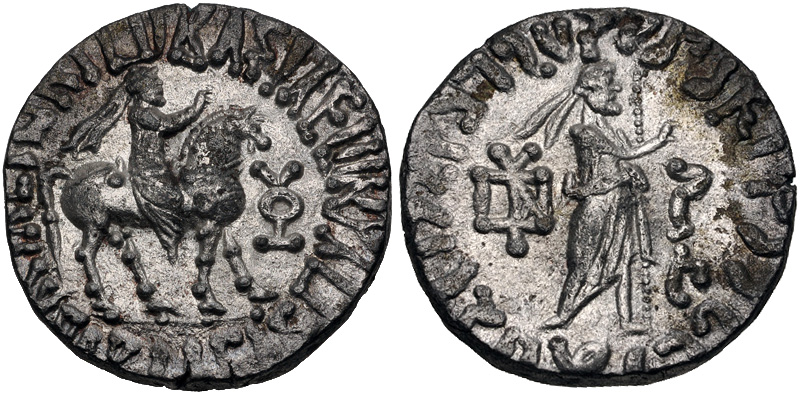

The situation gets complex because a symbol could be both a clan symbol, then with some changes and additions become a personal one.
Some symbols were also used for flags, banners and so on,
See previous thread on #flags in ancient Iran
Some symbols were also used for flags, banners and so on,
See previous thread on #flags in ancient Iran
https://twitter.com/Rostam_Persia/status/1540724874649505792?s=20&t=jcrdYH9t6jQiHj2ovK_BiQ
Related to our topic, I should briefly mention that the 3 dots we see on coins and other ancient Iranian artefacts is usually considered a symbol of #Tishtrya, divinity in Zoroastrianism.
It could also be a simpler astral sign
Also see




It could also be a simpler astral sign
Also see
https://twitter.com/Rostam_Persia/status/1492888094353367043?s=20&t=jcrdYH9t6jQiHj2ovK_BiQ




3) Triskele like sign, unknown clan
This one appears to be pretty important as a sign in #Sasanian era
Though we don't know the identity of the specific individual depicted with it here

This one appears to be pretty important as a sign in #Sasanian era
Though we don't know the identity of the specific individual depicted with it here


The reason I say important is b/c we see a number of seals with this design, with varying details
1-3: @metmuseum
4: Netherlands



1-3: @metmuseum
4: Netherlands




1-2: Another triskele or triskelion-like or World Triad device, @ Sackler
3: @britishmuseum : this one is really cool. It actually has 2 devices on it, a more complex one beside the hand!
⤵️



3: @britishmuseum : this one is really cool. It actually has 2 devices on it, a more complex one beside the hand!
⤵️




And there could be some connection with triskele and Greco-Roman triskelion as well, though with obvious differences when it comes to Greco-Roman symbol
1: Greek silver stater from Aspendos, Pamphylia (4th century BC)
2: Iron Age Castro culture triskele
3: Rainbow cup-Celtic


1: Greek silver stater from Aspendos, Pamphylia (4th century BC)
2: Iron Age Castro culture triskele
3: Rainbow cup-Celtic



1: Silver Drachma from Sicily, minted during the reign of Agathocles (361–289 BC)
2: Trisquel de Castromao
3: another possible connection: Gankyil Symbol in Buddhism
⤵️


2: Trisquel de Castromao
3: another possible connection: Gankyil Symbol in Buddhism
⤵️



4) An Official, possibly #Tansar
Going by historical era, the eminent scholar in this area, Sergey A Yatsenko, has identified this sign with Tansar from time of Ardashir I
ممکنه این یکی نشان #تنسر باشه



Going by historical era, the eminent scholar in this area, Sergey A Yatsenko, has identified this sign with Tansar from time of Ardashir I
ممکنه این یکی نشان #تنسر باشه




5) Kartir (کرتیر)
Another Mobed in later Sasanian era
A very influential one at that. Photos 1 and 4 from @rasoulipour's great work and website eranshahr.com/insignia
I find it interesting these 2 devices are somewhat similar!
⤵️



Another Mobed in later Sasanian era
A very influential one at that. Photos 1 and 4 from @rasoulipour's great work and website eranshahr.com/insignia
I find it interesting these 2 devices are somewhat similar!
⤵️




6) Possibly Papak, Vizier/minister of Bahram II
Photo 3 shows device on headwear. I'm doubtful about 1-2 b/c what person is holding is likely flower. I've seen that on seals, other places
In any event, this person appears together with Kartir on same relief
To be continued
⤵️


Photo 3 shows device on headwear. I'm doubtful about 1-2 b/c what person is holding is likely flower. I've seen that on seals, other places
In any event, this person appears together with Kartir on same relief
To be continued
⤵️



7) Possibly Yazdgerd I (یزدگرد یکم) based on a coin at BM
Note again that these devices were generally not used on gold coins, on coins where king's crown was clearly visible. They were instead used on pashiz, less valuable and poorly made coins like this one
Note again that these devices were generally not used on gold coins, on coins where king's crown was clearly visible. They were instead used on pashiz, less valuable and poorly made coins like this one

9) Foe on Hormizd II's Relief
NOTE this has been erroneously identified with potential device of Papak. This one is different*
It has additional details below the device, and is of a foe/enemy of Hormizd II

NOTE this has been erroneously identified with potential device of Papak. This one is different*
It has additional details below the device, and is of a foe/enemy of Hormizd II


10) Crescent and sun as device on hat of another noble person, unidentified
Note it gets interesting b/c crescent and sun or star was also used as a banner/standard, and on some Sasanian kings' crowns etc. So we see use of similar or same symbol in various contexts

Note it gets interesting b/c crescent and sun or star was also used as a banner/standard, and on some Sasanian kings' crowns etc. So we see use of similar or same symbol in various contexts


11) Possible personal devices of some Sasanian kings on some coins (photo 2)
Also compare again with use of Ardashir I and Shapur I's devices as dynastic devices on later #Sasanian coins (photo 1)
⤵️

Also compare again with use of Ardashir I and Shapur I's devices as dynastic devices on later #Sasanian coins (photo 1)
⤵️

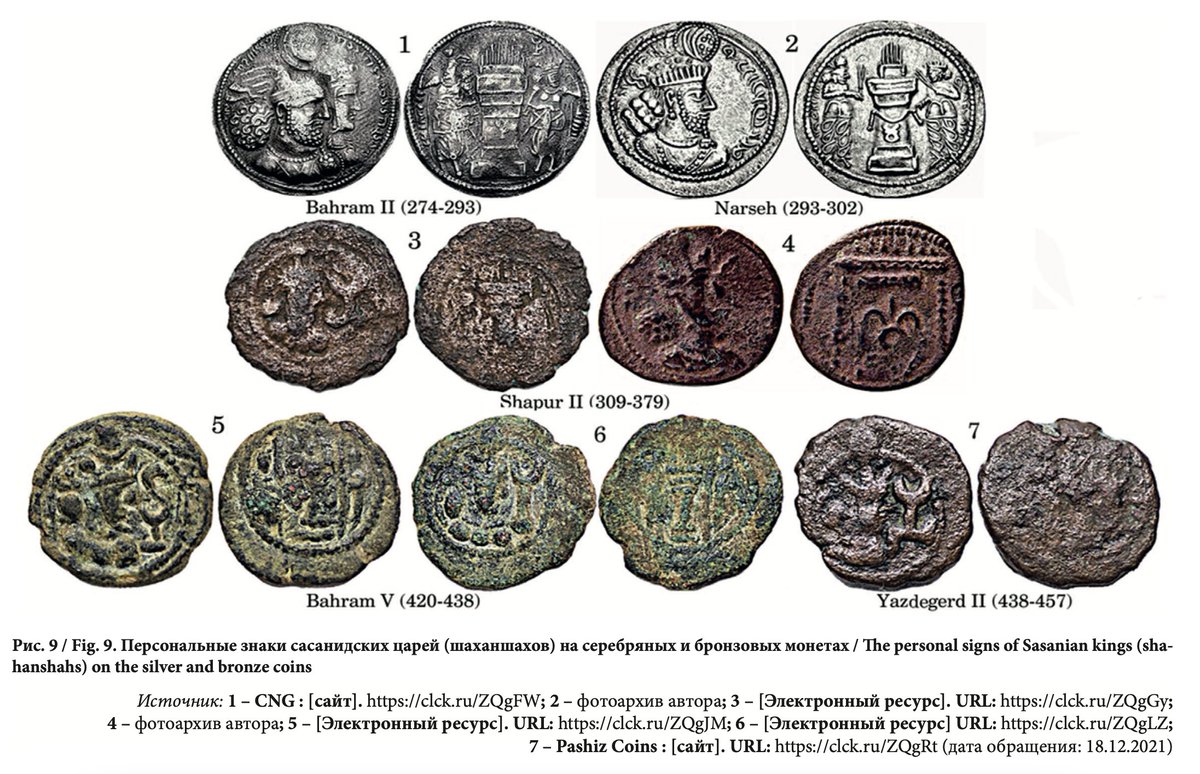
And see this Sasanian silver container with multiple devices on it, some of which we talked about before
⤵️


⤵️
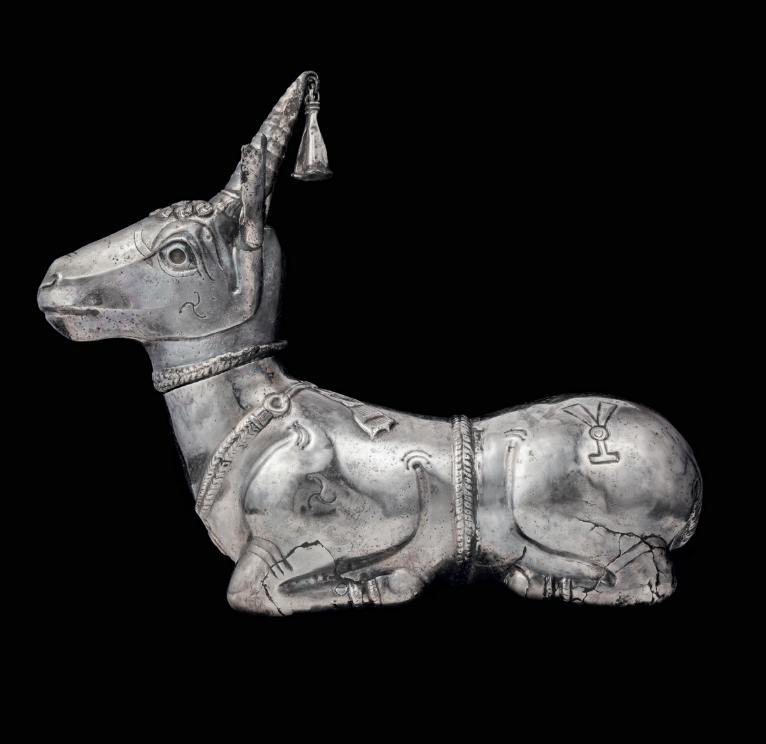


Now these were just the simpler devices! Numerous clans, families, individuals then would have very elaborate designs with endless possibilities
این نشانهایی رو که تا حالا دیدیم ساده تر بودن. خاندان ها و اشخاص نشانهای بسیار پر نقش و نگارهم استفاده میکردن.
این نشانهایی رو که تا حالا دیدیم ساده تر بودن. خاندان ها و اشخاص نشانهای بسیار پر نقش و نگارهم استفاده میکردن.
It's not always easy to identify these.
Some can be considered "monograms", perhaps of 3 general types: stylized device, pure letter device, complex mixed ones
Only seals with inscriptions could really be compared with letters or symbols of monograms to decipher them



Some can be considered "monograms", perhaps of 3 general types: stylized device, pure letter device, complex mixed ones
Only seals with inscriptions could really be compared with letters or symbols of monograms to decipher them




There is sometimes disagreement in reading & deciphering of these complex devices, and I'm only providing a few examples! There are hundreds if not thousands around the world!
See for example this reading of complex monogram
⤵️
See for example this reading of complex monogram
⤵️

Such complex devices & insignia must have been highly prized. "Seals bearing them were probably used by numerous members, dependants, servants of a given clan or estate, resulting in many duplicates."
"At the same time, merchants, clergy, officials, etc., of middle classes
"At the same time, merchants, clergy, officials, etc., of middle classes
were employing the animal and other motifs [simpler ones] as personal emblems. It is, in fact, animal devices which the #Shahnameh chiefly recalls. The continual association of name and device in the epic is noteworthy. e.g., 'I do not know him by his name and device'
'Whose was the name and device of this letter?' etc.
So Shahnameh is once again very important in understanding the usage and some social aspects of use of devices, e.g., "when Khosrow asked [the merchant] his name and device... he told Khosrow his device directly" [Sasanian
So Shahnameh is once again very important in understanding the usage and some social aspects of use of devices, e.g., "when Khosrow asked [the merchant] his name and device... he told Khosrow his device directly" [Sasanian
Stamp Seals in the Metropolitan Museum of Art, Brunner]: see this publication available freely online for details of numerous complex monograms and devices*
See these examples
⤵️



See these examples
⤵️




Also these
1: @britishmuseum , Perozhormizd, son of the Kanarang, and NOT Hormizd the king as sometimes wrongly identified
2: @ Sackler
4: @ MET
Also see one at Getty museum: getty.edu/art/collection…



1: @britishmuseum , Perozhormizd, son of the Kanarang, and NOT Hormizd the king as sometimes wrongly identified
2: @ Sackler
4: @ MET
Also see one at Getty museum: getty.edu/art/collection…




So these personal identity marks, devices, insignia, have a long history in Eurasia, including in #Iran.
"Heraldic insignia as the coats of arms of the European aristocracy are still in use today" [See Tamgas, a Code of the Steppes, Niccolò Manassero, 2013]
"Heraldic insignia as the coats of arms of the European aristocracy are still in use today" [See Tamgas, a Code of the Steppes, Niccolò Manassero, 2013]
"in human societies the reminders about identity and ownership may be expressed mainly by physical or visual means and by linguistic means, namely by marks and words."
"Just like advertising marks, identity marks always had to be clearly identifiable"
"Just like advertising marks, identity marks always had to be clearly identifiable"

But "the appearance of Iranian tamgas is seldom plain and geometrical as is that of the advertising brands: rather, tamgas are often complicated, asymmetrical and unclear, thus giving rise to many different hypotheses about their meaning and origins."
"Both writing and tamgas were developed for the same needs, namely for accounting. They are two different responses, or rather two different steps of the same response to the demand for adequate social rules to regulate and guarantee personal properties." [(Cf. Gelb 1968, p. 36]
"Tamgas arise in social milieus where written communication is absent, where information is con- veyed through spoken language or through visual and physical means."
Note from an academic perspective, I find this another important indication of lack of importance placed
Note from an academic perspective, I find this another important indication of lack of importance placed
in ancient Iranian society, especially in earlier stages, on writing everything down.
We see evidence (or lack of evidence) of this in Parthian society with Gosans (minstrels) which were (are?) still a part of #Armenian society and culture, among many other signs.
We see evidence (or lack of evidence) of this in Parthian society with Gosans (minstrels) which were (are?) still a part of #Armenian society and culture, among many other signs.
It's also important to separate Nishans from Monograms : "Monograms were specifically created within a social order regulated by institutions not relying on blood-relationship. In contrast, tamgas belong to small social orders based on blood-relationship."
"monograms are marks expressing identity by an individual: they are in effect signatures... On contrary, tamgas are marks expressing identity & ownership by a clan, a group of relatives."
So it might be difficult to identify monograms on seals... compared to devices @rasoulipour
So it might be difficult to identify monograms on seals... compared to devices @rasoulipour
"Later Sasanian devices show an increasing tendency to absorb monographic elements; this trend paralleled the freer use of abbreviations generally.” In other words, “Sasanian monograms” were actually tamgas. But in late Sasanian age, some engravers began to adapt
Pahlavi letters to the layout of those tamgas, likely for aesthetic reasons and as an intellectual game — that is, for the same reasons that might have led Greek mint- ers to create monograms as signatures on coins." [Niccolò Manassero] 







Also see numerous papers by Sergey Aleksandrovich Yatsenko, including Nishan-Signs of the Aristocracy of Sasanian Iran / Знаки-нишан аристократии сасанидского Ирана . Moscow, 2021: available online.
In any event, if we want to have a project identifying Sasanian Nishans, we need to separate personal marks (with some monographic elements) from clan ones
Also note the Nishan of last king of Parthian empire is more likely a "family crest", at least one of them for #Arsacids
Also note the Nishan of last king of Parthian empire is more likely a "family crest", at least one of them for #Arsacids
"#Artabanus IV, is identified at Firuzabad by a tamga composed by a ring on the top of a vertical
staff. This mark, which first appeared under Orodes II and was depicted on both obverses and reverses of Parthian coins, is a “sort of family crest” and is usually called
staff. This mark, which first appeared under Orodes II and was depicted on both obverses and reverses of Parthian coins, is a “sort of family crest” and is usually called
“the Arsacid symbol” by scholars (see Grabowski 2011, p. 220; Sinisi 2012, p. 64) [Niccolò Manassero]
Also again see eranshahr.com/insignia
🙏🙏🔆🌙

Also again see eranshahr.com/insignia
🙏🙏🔆🌙


@threadreaderapp unroll
2 other possible Parthian era precursors or connections to Ardashir I's and Sasanian royal house's device/ Nishan
1: Parthian era Elymais, Phraates (from Parthia website online)
2: Significant archeological find at Mele Hairam by Prof. Barbara Kaim and colleagues

1: Parthian era Elymais, Phraates (from Parthia website online)
2: Significant archeological find at Mele Hairam by Prof. Barbara Kaim and colleagues


Again, like other devices these could have been independently used for generations and one is not necessarily derived from the other
These are identified as pawns, available online, see ALT text
These are identified as pawns, available online, see ALT text

Also I share this categorization of royal Sasanian devices, though not sure if it's wholly accurate
I do not think Hormizd II's device is identified correctly. That seems to be for another individual from their seal, as shared earlier in thread, but see e.g., Yazdgerd II's coin

I do not think Hormizd II's device is identified correctly. That seems to be for another individual from their seal, as shared earlier in thread, but see e.g., Yazdgerd II's coin
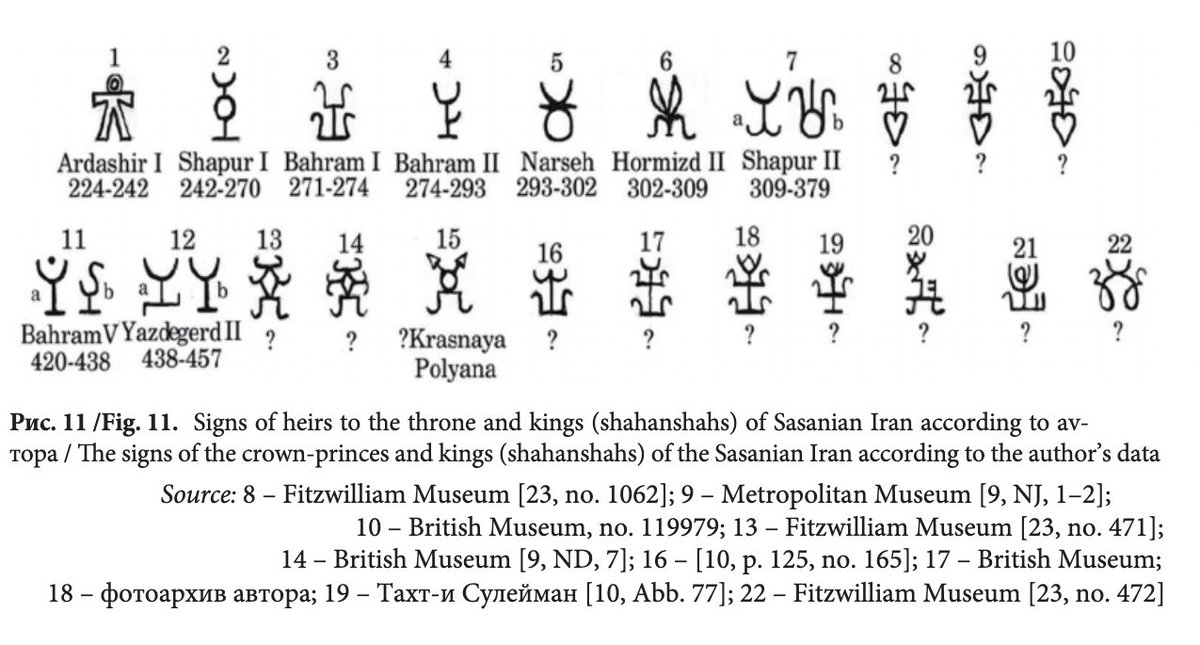

Significant Addendum:
I have found 3 Ardashir I coins now, which have what has been labeled "tamga" or "Frawahr" symbol on headwear or shoulders. We can't make out the full symbol, but it does appear to have replaced the place of usual star on head
These are exceedingly rare!


I have found 3 Ardashir I coins now, which have what has been labeled "tamga" or "Frawahr" symbol on headwear or shoulders. We can't make out the full symbol, but it does appear to have replaced the place of usual star on head
These are exceedingly rare!



2 are from trusted sources, British Museum & American Numismatic Society.
Also see this apparent seal with same or similar device. I can't find original location, possibly Austria: from Sylloge Nummorum Sasanidarum
Also see this apparent seal with same or similar device. I can't find original location, possibly Austria: from Sylloge Nummorum Sasanidarum

Finally see Parthika at fr website for a page on anchor symbol also on some Parthian coins, and a little more on 3 devices I talked about: link in ALT text so it doesn't get blocked! 



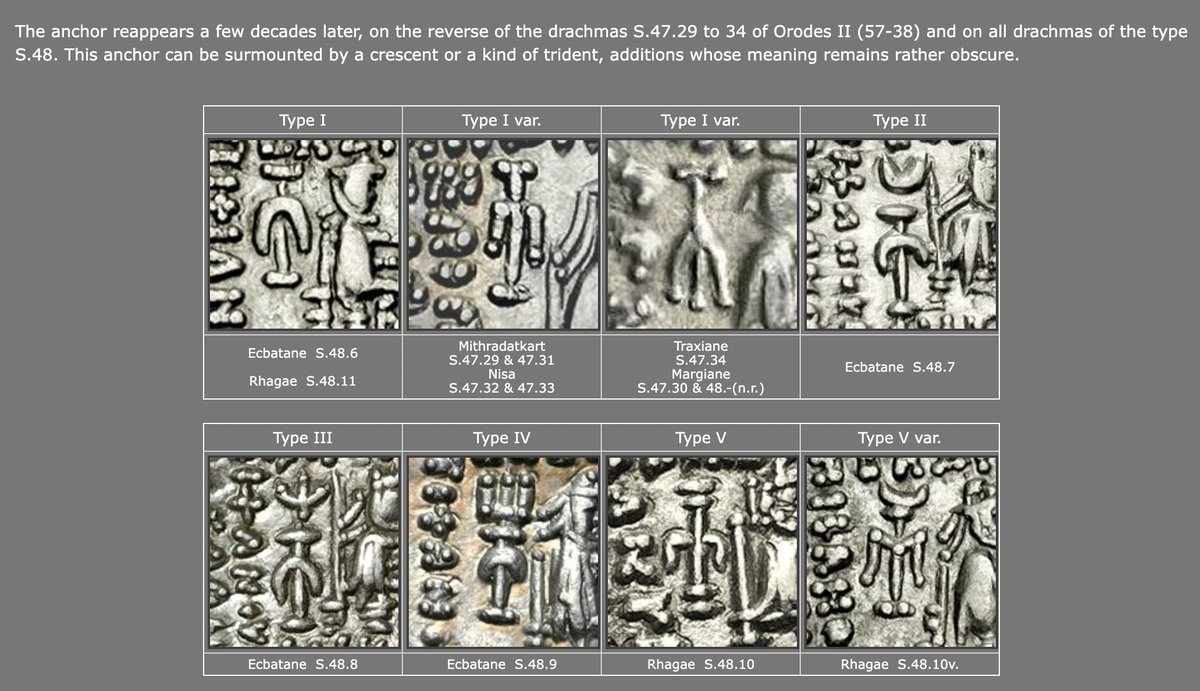

2 more examples:
A Triskelion on a coin (photo 2) minted at city of Aspendos, counter-marked, found in Persepolis
1: Achaemenid era seal with Triskelion-like design


A Triskelion on a coin (photo 2) minted at city of Aspendos, counter-marked, found in Persepolis
1: Achaemenid era seal with Triskelion-like design
https://twitter.com/orientalinst/status/1549114457086902275?s=20&t=6FjPW29Rnfeb9kPMLzxHXw


Schaaf Collection:
1: Clearer view of Ardashir I's device on his crown
2: Also on crown of Shapur I
See ALT text for Princeton U Library links. Only coin I've seen of Ardashir I with clear image of his device!! REALLY COOL!

1: Clearer view of Ardashir I's device on his crown
2: Also on crown of Shapur I
See ALT text for Princeton U Library links. Only coin I've seen of Ardashir I with clear image of his device!! REALLY COOL!

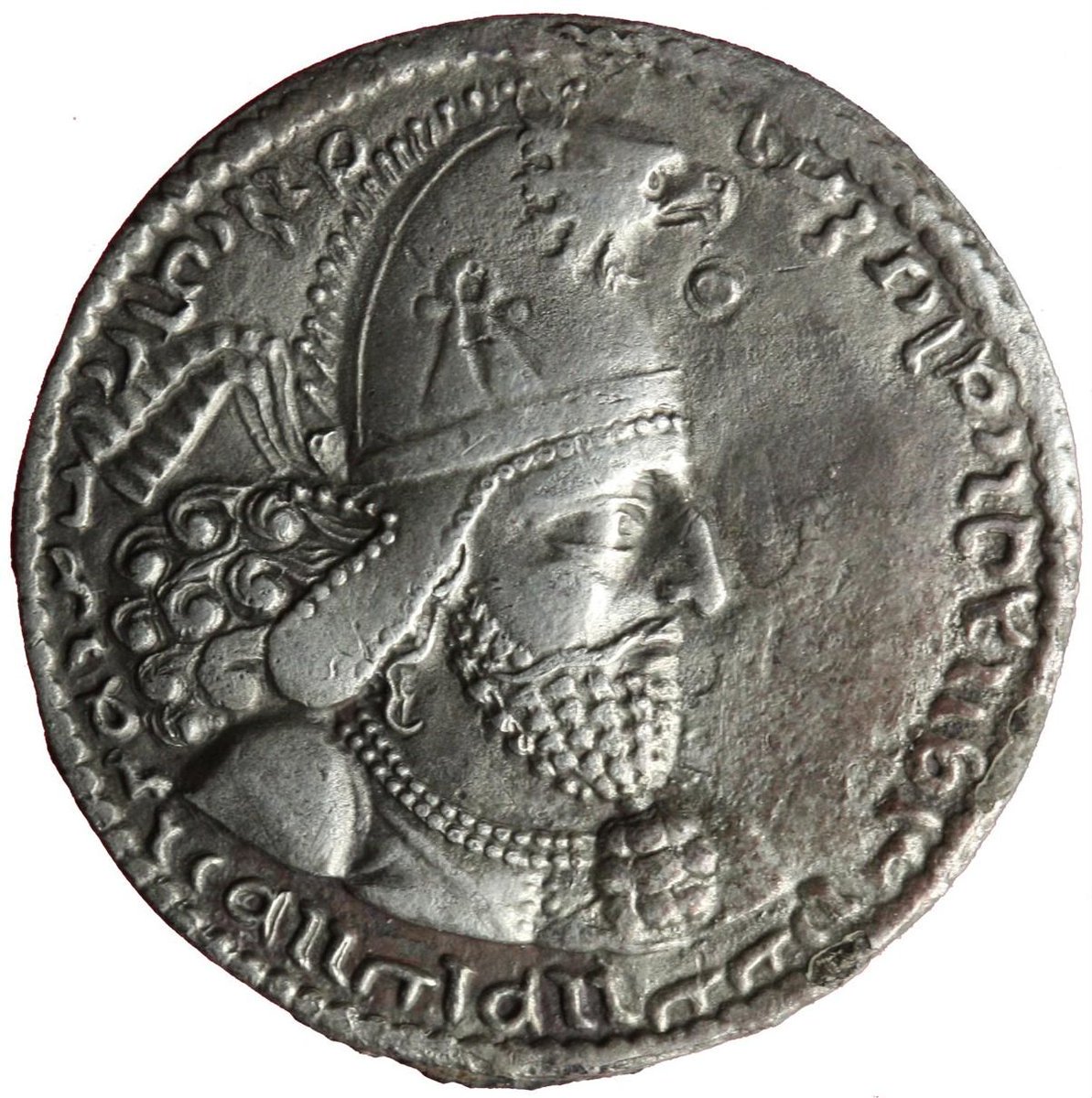
I was able to track down this important seal: in Saeedi Collection
Published 2003 by Rika Gyselen in “Dīwān et «Trésorerie» sassanides: premières attestations sigillographiques”
2: To the left, seal of a dīwān; To the right, seal of the royal Treasury

Published 2003 by Rika Gyselen in “Dīwān et «Trésorerie» sassanides: premières attestations sigillographiques”
2: To the left, seal of a dīwān; To the right, seal of the royal Treasury


MP legend around perimeter reads “Seal of the Treasury which is in good increase” (Middle Persian: muhr ī ganj ī pad abzōn wēh). Here symbol is called frawahr. "It appears in many fields closely related with the House of Sāsān (rock reliefs, coins, etc.)"
⤵️
⤵️

In Gyselen’s opinion, presence of symbol must hint towards royal status for this “Treasury” [original article in French]
این مهر در کلکسیون سعیدی هست. مهر خزانه سلطنتی دوره ساسانی است. نشان رو اینجا "فروهر" نامیده اند, که همون نشان خاندان ساسانی است.

این مهر در کلکسیون سعیدی هست. مهر خزانه سلطنتی دوره ساسانی است. نشان رو اینجا "فروهر" نامیده اند, که همون نشان خاندان ساسانی است.
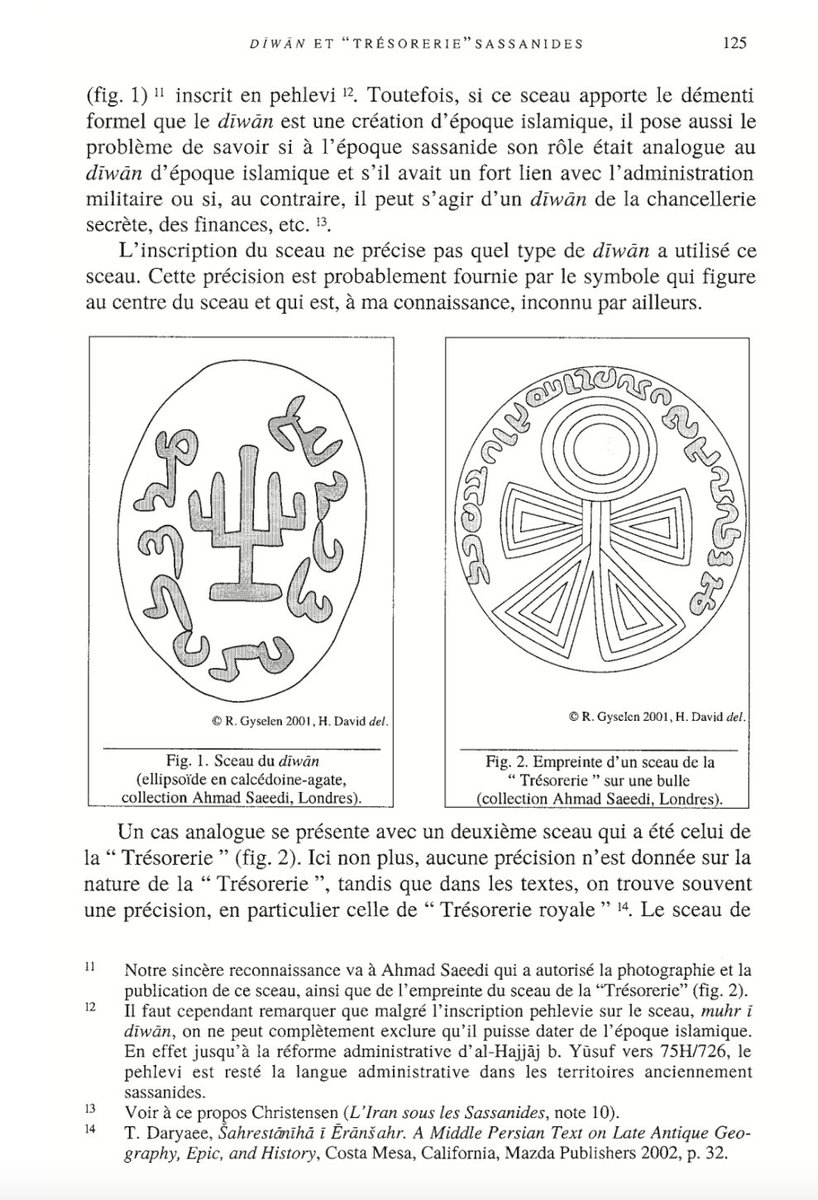

• • •
Missing some Tweet in this thread? You can try to
force a refresh








